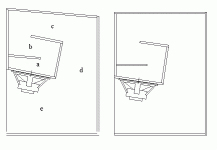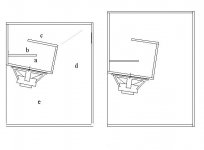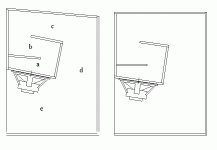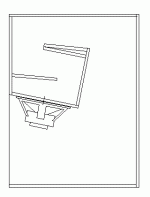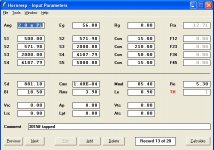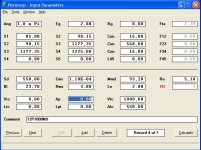Don Snyder said:
P.S. take a look at the Beyma 12LX60. Some guys in Germany are using it.
Are they measuring the results? Got links?
Hi Just,
About 6 months ago, tupaki surfaced, thanked us, and then disapeared. He seemed delighted with his build of my double
fold of Cowans 30 Hz horn. Just last week, I stumbled on a German speaker forum and recognized his name. I did see some
links to measurements, but I didn't follow them.
Here is the URL:
http://babelfish.yahoo.com/translat...=1&idx=17799&&lp=de_en&.intl=us&fr=slv8-hptb5
About 6 months ago, tupaki surfaced, thanked us, and then disapeared. He seemed delighted with his build of my double
fold of Cowans 30 Hz horn. Just last week, I stumbled on a German speaker forum and recognized his name. I did see some
links to measurements, but I didn't follow them.
Here is the URL:
http://babelfish.yahoo.com/translat...=1&idx=17799&&lp=de_en&.intl=us&fr=slv8-hptb5
Oh! That is tooo funny! Great Pix and all, but bablefish has a mean sense of humor.Don Snyder said:
Bookmarked for anytime I feel in need of a giggle. No disrespect to the posters on the German forum or Don's good work, it's all in the translation

any Hintergrundgerumpel and murmurings or if possibly behind the stage approximately baselt merciless transfer someone somewhere.
Charles.
Don Snyder said:P.S. take a look at the Beyma 12LX60. Some guys in Germany are using it.
Looks nice but it's severely xmax limited at 40hz
For sine waves yes, for music no. This box could do 1000 watts of 6 string electric bass. Remember, the fundamental is 10 dB below
the 2nd harmonic, so at one meter the lowest note would be 115 dB of 30Hz and 125dB of 60Hz.
I believe xmax on the Beyma is 9mm but only 6mm on the Definimax.
Start running sine waves thru your high end HiFi or PA gear, and you'll have blown speakers up to your @$$.
the 2nd harmonic, so at one meter the lowest note would be 115 dB of 30Hz and 125dB of 60Hz.
I believe xmax on the Beyma is 9mm but only 6mm on the Definimax.
Start running sine waves thru your high end HiFi or PA gear, and you'll have blown speakers up to your @$$.
Do you think it's safe to assume that people aren't going to play music (ie. electronica?) where there is sine wave like content?
The current design I'm tinkering with is not xmax limited within my intended passband, but I'm only going to give it 300W. Better safe than sorry?
The current design I'm tinkering with is not xmax limited within my intended passband, but I'm only going to give it 300W. Better safe than sorry?
"Is it safe?"
Safe is boring! DJ's read their playlists by the red glow of the overload indicators. From the 1812 overture on, no speaker is
safe. Go to Danley's website and download his recordings of fireworks. That stuff will blow your speakers.
DIY is pushing the frontiers, and ... no, it isn't safe.
But it's fun!
Safe is boring! DJ's read their playlists by the red glow of the overload indicators. From the 1812 overture on, no speaker is
safe. Go to Danley's website and download his recordings of fireworks. That stuff will blow your speakers.
DIY is pushing the frontiers, and ... no, it isn't safe.
But it's fun!
Don Snyder said:"Is it safe?"
Safe is boring! DJ's read their playlists by the red glow of the overload indicators. From the 1812 overture on, no speaker is
safe. Go to Danley's website and download his recordings of fireworks. That stuff will blow your speakers.
DIY is pushing the frontiers, and ... no, it isn't safe.
But it's fun!
No PA sub is safe without a HP filter, especially one without a very small rear chamber... just because occasionally you'll get 'something' below 40hz, accidental, or intentional, Like this: http://www.diyaudio.com/forums/showthread.php?postid=1770573#post1770573
Hey don, on dual taper, wouldn't a box like mine that you kindly drew up, be a great candidate for dual taper? Just change the taper at the upper back corner of the box?
I've actually gone to a 3 step process, creating a sim that looks promising, then creating a fold (rough) that may be somewhat close to the original sim, and then creating a new sim that more accurately represents what I just folded. AND THEN, working out the details of what I don't like in the design.
Is there an easier way? I know my big box was a great success, but it was a rush, and way too big, too heavy, and I didn't care, because it was a permanent install. I'd like to refine that cabinet a bit, shrink it as much as possible without going below 101db in the passband, and build a couple for myself... just because I have issues...
jbell said:
No PA sub is safe without a HP filter, especially one without a very small rear chamber... just because occasionally you'll get 'something' below 40hz, accidental, or intentional, Like this: http://www.diyaudio.com/forums/showthread.php?postid=1770573#post1770573
I should have been clearer - is there any reason not to be safe within the passband? Assuming appropriate HP filter..... Fun is nice, but I can't afford to replace blown drivers willy nilly

Hi Jim,
Iand says that the bend needs to be 50% or more thru the horn. The first two runs (a&b) only amount to 30%, so I think you need
to make the bend after c.
I'm not convinced it's worth the trouble because you give up bandpass and low frequency to get SPL and a flatter response
in HornResp.
HornResp is a great tool, but I want to see measurements before I will believe that these are real gains. After all, the third peak in
the SPL graph isn't really there.
Iand says that the bend needs to be 50% or more thru the horn. The first two runs (a&b) only amount to 30%, so I think you need
to make the bend after c.
I'm not convinced it's worth the trouble because you give up bandpass and low frequency to get SPL and a flatter response
in HornResp.
HornResp is a great tool, but I want to see measurements before I will believe that these are real gains. After all, the third peak in
the SPL graph isn't really there.
Attachments
Don Snyder said:
HornResp is a great tool, but I want to see measurements before I will believe that these are real gains. After all, the third peak in
the SPL graph isn't really there.
I'm looking for measurements too. Several people, including myself, are experiencing deep nulls right before the first big peak that don't correspond to the hornresp predictions. I think I know how to fix it, but not so sure exactly how to predict it.
Don Snyder said:Hi Jim,
Iand says that the bend needs to be 50% or more thru the horn. The first two runs (a&b) only amount to 30%, so I think you need
to make the bend after c.
Don:
Does this do it?
Attachments
In the left hand figure, the taper in a, b, & c is 6 degrees, then it changes to 11 degrees for d & e. In the right hand figure, all
tapers are 8 degrees. If a and b had been 50% of the length it would have been a simple matter to make two tapers.
The only way I could make two tapers with a, b, & c in the first taper, was by tilting the top, or having some dead areas inside.
tapers are 8 degrees. If a and b had been 50% of the length it would have been a simple matter to make two tapers.
The only way I could make two tapers with a, b, & c in the first taper, was by tilting the top, or having some dead areas inside.
Attachments
Don Snyder said:Hi Jim,
Iand says that the bend needs to be 50% or more thru the horn. The first two runs (a&b) only amount to 30%, so I think you need
to make the bend after c.
I'm not convinced it's worth the trouble because you give up bandpass and low frequency to get SPL and a flatter response
in HornResp.
HornResp is a great tool, but I want to see measurements before I will believe that these are real gains. After all, the third peak in
the SPL graph isn't really there.
The flare rate change doesn't *need* to be 50% or more along the horn, it's just that the further you push it towards the mouth the more volume you save in the first section, which can be used to volume of the second section, which increases the mouth area, which raises passband efficiency and reduces ripple.
By also increasing the length slightly to restore the LF rolloff you can get then same LF cutoff with higher efficiency and less ripple than a single flare TH.
There are various ways of folding such a TH -- I agree with the suggestion of tweaking the design, then see how this can be folded up, then tweak again to fit what you can actually build.
None of this takes very long, you can come up with a close-to-optimum design and a folding scheme in a couple of hours.
Ian
Hello iand,
You do agree that the logical place to put the "bend" is between c and d, don't you. I agree that it shouldn't take more than a
couple of hours to converge on a reasonable solution. Of course, the proof is in the pudding, so we won't know how successful we are until someone makes sawdust. After all, sims are sims.
Hey Jim,
Did the last explanation make sense?
You do agree that the logical place to put the "bend" is between c and d, don't you. I agree that it shouldn't take more than a
couple of hours to converge on a reasonable solution. Of course, the proof is in the pudding, so we won't know how successful we are until someone makes sawdust. After all, sims are sims.
Hey Jim,
Did the last explanation make sense?
Don Snyder said:Hello iand,
You do agree that the logical place to put the "bend" is between c and d, don't you. I agree that it shouldn't take more than a
couple of hours to converge on a reasonable solution. Of course, the proof is in the pudding, so we won't know how successful we are until
someone makes sawdust. after all, sims are sims.
Hey Jim,
Did the last explanation make sense?
Hi Don
Your folding schemes work fine (depending on the tap points, obviously) as do several others, depending on the aspect ratio of the cabinets you want to build.
I agree that the proof of the pudding is in the eating, but if it simulates better it's likely to perform better -- any errors between simulation and measurement (like HF peaks) aren't likely to be affected much, if they exist on a single flare TH they'll be there on a double flare TH.
Ian
Don Snyder said:Hello iand,
You do agree that the logical place to put the "bend" is between c and d, don't you. I agree that it shouldn't take more than a
couple of hours to converge on a reasonable solution. Of course, the proof is in the pudding, so we won't know how successful we are until someone makes sawdust. After all, sims are sims.
Hey Jim,
Did the last explanation make sense?
Yea it did, what I was thinking, was that the 'C' area could be a transition taper, neither 6 or 11... I know that wouldn't line up exact with hornresp sim, but then conic to parabolic doesn't exactly line up either...
I'll tell you what Don... If you (and/or others) come up with a great dual taper for the 3015lf.. I'll make the sawdust and test it out. sound fair?
maybe something like this? Looks pretty flat in groups of 4 without an inductor.
Attachments
- Home
- Loudspeakers
- Subwoofers
- Collaborative Tapped horn project
